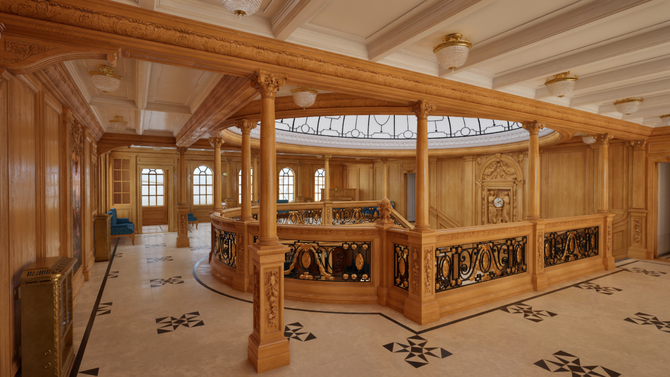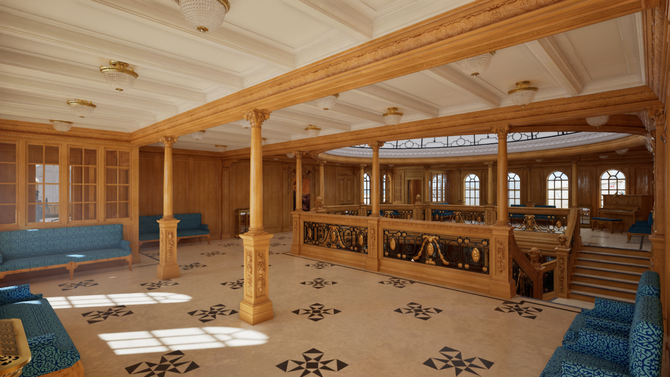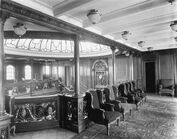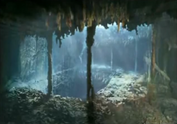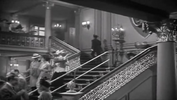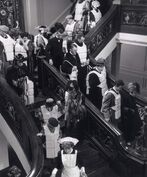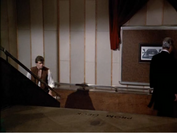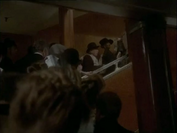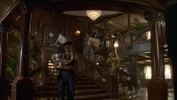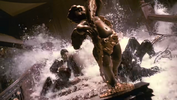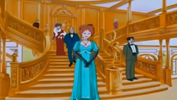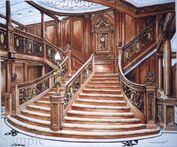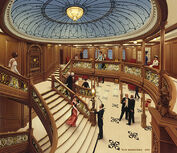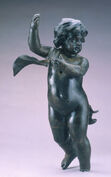The Grand Staircase was one of the most impressive features on board the RMS Titanic and the center of First Class activity. It was an opulent, lavish staircase that spanned six decks (from the Boat Deck to E Deck), continuing through to F Deck as an ordinary stairway. It was located between the first and second funnel. It is iconic, the best known location and viewed upon as the epitome of craftsmanship onboard the famous liner.
The main stairwell located in the forward part of the ship and began on the Boat Deck, extending six flights down to E-Deck. B and D-Decks contained entry foyers on either side where First Class passengers would embark and disembark, the D-Deck entryway leading directly into the Reception Room. Each level was constructed in solid English oak with sweeping curves and the surrounding spaces paneled in the sleek neoclassical William and Mary style. The balustrades displayed distinctive wrought iron grilles with ormolu swags in the style of Louis XIV. The A-Deck level was undoubtedly the most spectacular and is the most recognizable due to its frequent depiction in film.
The staircase was crowned by an extravagant wrought iron and glass dome with a large chandelier at the centre. The wrought-iron dome was installed on the roof of the boat deck and provided natural light to the stairwell before being artificially lit at night from behind. On the central landing of the A-Deck staircase was an exquisitely carved clock with allegorical figures on either side, known as 'Honor and Glory Crowning Time'. At the foot of the staircase, on the newel post of the middle balustrade, was a bronze cherub holding an electric torch. B and C-Decks probably had smaller replicas of these cherubs at either corner of the staircases and contained landscape oil paintings as the focal points of their landings instead of the unique clock on A-Deck.
After the ship sank, it was discovered that Titanic's Grand Staircase had never been photographed, so people started to re-use some images of Olympic's Grand Staircase instead. Slowly, several well-known images are claimed to be from Titanic, while they are all from Olympic.
Directly forward of the staircase, there were three lifts going from A-Deck to E-Deck, operated by three lift attendants: Frederick Allen, William Carney & Alfred John Moffett King. The lift attendants knew the ship very well and could provide directions to passengers if needed. They all died in the sinking.
On the aft section of the ship, there was the Aft Grand Staircase, a smaller and somewhat less ornate staircase, but otherwise strongly resembling the forward Grand Staircase. When the Titanic split in two right behind the aft staircase, a large chunk of the aft staircase dome remains intact in the debris field at the wreck site.
There is also a life-sized replica of the forward Grand Staircase in the Titanic Museum, Belfast and the upcoming video game Titanic: Honor and Glory also will prominently feature the Grand Staircase.
Levels[]
From the Grand Staircase, a passenger could access almost all of the facilities available in First Class, level by level:
- The Boat Deck level gave access to the outside promenade space, sun deck, the lifeboats, and the adjoining Gymnasium. The A-Deck level accessed First Class accommodation at the forward part of the ship and the grand public rooms located further aft via a long corridor. Entry vestibules opened onto the encircling Promenade Deck from the stairway.
- B and C-Decks connected to the main corridors containing the bulk of First Class accommodation, including the extravagant 'Millionaire's Suites' located immediately off the B-Deck level staircase. On the Starboard side of the C-Deck staircase was the Purser's Office, where passengers stored their jewelry and other valuable belongings during the voyage.
- On D-Deck the staircase opened directly onto the Reception Room and adjoining Dining Saloon. Instead of a cherub, the central post of the staircase contained an impressive gilt candelabra with electric lights. Behind the staircases were installed the three First Class elevators which ran between E and A-Decks.
- On E-Deck the staircase narrowed and lost the sweeping curve of the upper flights; a modest single flight terminated on F-Deck, where the Turkish Bath and Swimming Pool could be reached.
Construction delay & the clock[]
Titanic's construction was delayed twice due to incidents with the Olympic. The first incident occurred on September 20th, 1911, when the Olympic collided with the HMS Hawke. The second incident occurred in February when the Olympic lost a propeller blade on an eastbound crossing. Because of these delays, Titanic's Maiden Voyage was pushed back from March 20th to April 10th. In spite of this delay, Titanic was still largely incomplete as her Maiden Voyage drew near. Work was conducted on the vessel until the very last minute. The impact of this was noticeable in some areas of the ship. Many public spaces in both Second and Third Class were not fully furnished, and many unoccupied staterooms weren't even prepared for passenger use.
Perhaps most notable of all, the famous clock at the A-Deck landing of the Grand Staircase, named Honor and Glory Crowning Time, may never have been installed on the ship at all. Though impossible to prove, there are a few pieces of evidence that point towards this possibility. None of the passengers ever made note of seeing a clock on the Grand Staircase during the voyage in their recollections and it was reported by workers that a mirror had temporarily been put in place of the clock less than a week prior to sailing day. While workers could recall without a shadow of a doubt the mirror being in place in the Grand Staircase, none could ever recall whether or not the clock itself was finally installed prior to the ship's departure. As such,it is possible that the mirror remained in place when Titanic set sail and that the famed clock was never on board at all.
Differences[]
HMHS/RMS Britannic[]
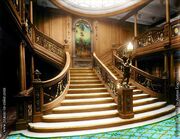
What RMS Britannic's Grand Staircase would've looked liked if she survived the war
The Grand Staircase remained the same layout except it was planned to have a decorative blue color scheme, and on the aft wall on A-Deck and Boat Deck, a pipe organ was to be installed. It would have the ability to either be played manually with keys or using a roll to play it automatically. The instrument still exists today in playable condition in the Museum für Musikautomaten in Seewen, Switzerland. The addition of the large instrument also made for the removal of the flooring on Boat Deck on the aft side of the stairwell, so passengers could only get from one side of the staircase on Boat Deck by walking down to the central landing and back up the other side. The floor on A-Deck would have also been made of a dark greenish-blue tiles in a different pattern, instead of the black and white floor pattern on Titanic. In addition, the electric lifts on Britannic went up to the Boat Deck instead of terminating at A-Deck like they did on Olympic and Titanic. There were also larger rails over the light shafts on either side of the staircase and some believe Honor & Glory Crowning Time was replaced by a landscape painting.

Olympic's Grand Staircase after a refit in 1933
RMS Olympic[]
On the Olympic, the Grand Staircase was identical. Later on in Olympic's career, the Grand Staircase was painted green (In an attempt to match the Art Deco style which became popular in the 1920s) and extra handrails were installed on the staircase, along with tiny paintings along some walls, red curtains, more furniture, and golden embellishing's.
Sinking[]
When it was 12:45 A.M, Titanic seemed to be in a relatively stable position. Her forward trim was not increasing much, at an angle of roughly 3°. Her list to starboard was not big enough to notice for most. For all on board, it was evident that the ship was taking on water, though she still seemed to be stable and secure. Few felt she would sink, even among the ship's crew. Steward John Wheat seemed to have a different impression, however. Earlier, he had assisted in closing some of the watertight doors along E-Deck and F-Deck. While he did not see any water during this task, it may have left something of an impression on him, for around this time Steward Wheat decided to break away from his duties long enough to proceed to his quarters on F-Deck and retrieve some of his personal belongings.
When Wheat entered E-Deck by means of the Grand Staircase, he found it devoid of life. The Third Class passengers with cabins in the bow had been driven out by the rising water, making an exodus to the stern of the ship as they sought refuge. The crew and passengers that had quarters along E-Deck had all been roused and sent up top. Surrounded by an eerie silence. Wheat continued down the stairs to his quarters, located down a short hallway that extended off of the F-Deck Grand Staircase landing. After retrieving his belongings, Wheat took a moment to ensure that all the others housed here-primarily Turkish Bath attendants had all been roused from their quarters. Finding no one remaining, he returned to the stairwell - only to find water tricking down. Rushing back up to the E-Deck landing, Wheat found that water had made its way through the corridor along the starboard side of the vessel. Although water was present at 12:30 A.M, it was flowing back to F-Deck from the front, as it was spilling over a bulkhead, as Wheat noticed. It was flowing around the corner and down the stairs into F-Deck. Wheat was witnessing firsthand the beginning of Titanic's end. At 1:00 A.M. Titanic only had another hour and 20 minutes left.
The water would probably make it to D-Deck at probably 1:25 A.M. C-Deck would begin to flood at approximately 1:40 A.M. The sinking rate increased after that. B-Deck started to flood at 1:50 A.M and reached A-Deck just before 2:00 A.M. It isn't known if people were standing in the staircase when water was at the A-Deck landing. The following information is simply speculation and guesses, as nobody who was inside the Grand Staircase from this point onwards survived the sinking. A-Deck windows began to shatter which increased the rate of flooding. On the outside of the staircase, on the Boat Deck, water began to rise over the walls. At 2:12 A.M, the water was soon covering the Boat Deck stairwell. It is believed by many members of the general public that the dome atop the staircase shattered from the pressure of the water overhead, rapidly flooding what was left of the staircase. This belief comes from James Cameron's depiction of the staircase's final moments, however, there is no evidence of this happening.
There is no way to confirm or disprove that the dome shattered from the water pressure. What we do know is that as the staircase was completely flooded, the entire stair fixture spanning from E-Deck all the way to Boat Deck broke free from the stairwell and floated upwards. It broke apart, and much of the debris floated to the surface through various holes and openings in the ship. This was discovered in the filming of Cameron's movie, in which a replica of the Grand Staircase, built in the exact same way as the real thing, was rapidly flooded. During the filming, the stairs floated up and pinned a few actors to the railings. This finding is also supported by the lack of any debris from the Grand Staircase in the wreck. The windows begin to form a little whirlpool, sucking in passengers nearby. There is a claim that the one of the women in First Class was sucked into the staircase with her mother but it is not for sure. There were only 4 ladies in First Class that didn't survive the sinking, neither of them were a mother of a victim.
However, there was a passenger named Archibald Gracie IV who was between 1st and 2nd funnel above the roof and felt a huge suction when he was about to let go of the railing close to the Grand Staircase dome.
Wreck[]
- Another theory of the staircase's destruction: The staircase (Boat-C Decks) was ripped out of the foundation of the ship while it was sinking, and both D and E-Deck staircase was destroyed by the down-blast effect.
- The Grand Staircase was completely destroyed twice, first when the domed skylight collapsed during the initial sinking. Then secondly, the Grand Staircase was completely ejected from the ship up through the hole left by the skylight during the plunge of the bow section to the ocean floor. The stairs to the decks were never found because any remaining stairs completely disintegrated when the bow hit the bottom of the ocean. However, a chandelier that hung in The Grand Staircase A deck landing foyer was seen dangling from the ceiling and photographed extensively in 1986 (the year after the wreck of Titanic was first discovered in 1985) for the filming of the National Geographic documentary 'Secrets of The Titanic' (released in 1987) and also during later expedition dives to the wreck (such as James Cameron's dives for his 1997 film).
- On the wreck of the Titanic, the staircase has long gone. The ornate panels have been eaten away and the glass dome is gone leaving a gaping hole, however with the staircase and dome now gone from the wreck, the large hole provides easy access for exploring submersibles to gain entry into the ship. As of 2012, the Boat Deck level of the deckhouse has collapsed onto A-Deck. The framework of the D & E Deck landings are still in the wreck.
In popular culture[]
- The Nazi propaganda film shows the Grand staircase as a metaphor for the avarice of the British and American upper classes.
- Jean Negulesco's 1953 film has a number of scenes set on the Grand Staircase, though it bears only a superficial resemblance to the real one.
- A Night to Remember features scenes on the Grand Staircase, with recreations of the A and D-Deck levels. The sets were based on archival photographs of the Olympic, lending them a general appearance of authenticity.
- S.O.S. Titanic used a staircase from a mansion in London's Belgrave Square; it bore no relation to the appearance of the one on Titanic.
- The 1996 CBS miniseries Titanic features a recreation of the Grand Staircase, though it wrongly locates the A-Deck level, with its distinctive clock and cherub light fixture, opening directly onto the D-Deck dining saloon. It also eliminates the glass dome and the entire Reception Room.
- The staircase was a major focal point in James Cameron's 1997 film as well. The forward Grand Staircase, decks A through D, were accurately built to the correct proportions, although the model that was used was 30% larger than the actual staircase.
- In the Legend of the Titanic the Grand Staircase is used as a dance floor or hall which is contradictory, it also looks similar like the staircase on the Britannic. For the part on the way up to the boat deck seems squarer in shape that of circular shape and had curtains and mirrors which is not featured on the Titanic's Grand Staircase.
- The staircase is not featured in In Night and Ice and 2012 mini-series, making it the only major productions about the Titanic to exclude it.
Galleries[]
Sadly, the Titanic's Grand Staircase was never photographed before she sank, however Olympic's Grand Staircase was similar to that of her sister ship.

